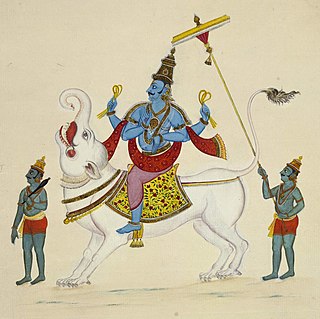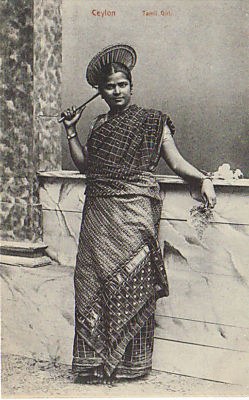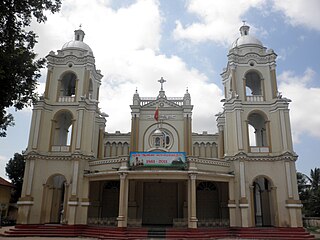
Varuna is a Hindu god, associated with the sky, oceans, and water. In the Vedic scriptures, he is paired with the god Mitra and is the lord of Ṛta (justice) and Satya (truth). Varuna is also mentioned as an Aditya, the sons of the goddess Aditi.
The caste systems in Sri Lanka are social stratification systems found among the ethnic groups of the island since ancient times. The models are similar to those found in Continental India, but are less extensive and important for various reasons. Modern times Sri Lanka is often considered to be a casteless society in south asia.

The Jaffna kingdom, also known as Kingdom of Aryachakravarti, was a historical kingdom of what today is northern Sri Lanka. It came into existence around the town of Jaffna on the Jaffna peninsula and was traditionally thought to have been established after the invasion of Kalinga Magha from Kalinga in India. Established as a powerful force in the north, northeast and west of the island, it eventually became a tribute-paying feudatory of the Pandyan Empire in modern South India in 1258, gaining independence when the last Pandyan ruler of Madurai was defeated and expelled in 1323 by Malik Kafur, the army general of the Delhi Sultanate. For a brief period in the early to mid-14th century it was an ascendant power in the island of Sri Lanka, to which all regional kingdoms accepted subordination. However, the kingdom was overpowered by the rival Kotte kingdom around 1450 when it was invaded by Prince Sapumal under the orders of Parakramabahu VI.

Sri Lankan Tamils, also known as Ceylon Tamils or Eelam Tamils, are Tamils native to the South Asian island state of Sri Lanka. Today, they constitute a majority in the Northern Province, form the plurality in the Eastern Province and are in the minority throughout the rest of the country. 70% of Sri Lankan Tamils in Sri Lanka live in the Northern and Eastern provinces.
Sri Lankan Mukkuvar is a Tamil speaking ethnic group found in the Western and Eastern coastal regions of Sri Lanka. They are primarily concentrated in the districts of Puttalam, Batticaloa, and Amparai.
Koviyar is a Tamil caste found in Sri Lanka. They are traditional agriculturalists and temple workers but also included merchants, landowners and temple patrons. Kattavarayan as caste deity is observed by the Koviar. They are reputed as a ritually dominant caste and the "cousin" caste of the more numerical dominant caste, Sri Lankan Vellalar.

Karava is a Sinhalese speaking ethnic group of Sri Lanka, whose ancestors migrated throughout history from the Coromandel coast, claiming lineage to the Kaurava royalty of the old Kingdom of Kuru in Northern India. The Tamil equivalent is Karaiyar. Both groups are also known as the Kurukula.
The following is a chronological overview of the history of the Karavas and Karaiyars caste of Sri Lanka and India. Both communities were historically also known as Kurukulam, meaning Kuru clan.
Sri Lankan Vellalar is a caste in Sri Lanka, predominantly found in the Jaffna peninsula and adjacent Vanni region, who comprise about half of the Sri Lankan Tamil population. They were traditionally involved in agriculture, but also included merchants, landowners and temple patrons. They also form part of the Sri Lankan Tamil diaspora.

The Vanni chieftaincies or Vanni tribes was a region between Anuradhapura and Jaffna, but also extending to along the eastern coast to Panama and Yala, during the Transitional and Kandyan periods of Sri Lanka. The heavily forested land was a collection of chieftaincies of principalities that were a collective buffer zone between the Jaffna Kingdom, in the north of Sri Lanka, and the Sinhalese kingdoms in the south. Traditionally the forest regions were ruled by Vedda rulers. Later on, the emergence of these chieftaincies was a direct result of the breakdown of central authority and the collapse of the Kingdom of Polonnaruwa in the 13th century, as well as the establishment of the Jaffna Kingdom in the Jaffna Peninsula. Control of this area was taken over by dispossessed Sinhalese nobles and chiefs of the South Indian military of Māgha of Kalinga (1215–1236), whose 1215 invasion of Polonnaruwa led to the kingdom's downfall. Sinhalese chieftaincies would lay on the northern border of the Sinhalese kingdom while the Tamil chieftaincies would border the Jaffna Kingdom and the remoter areas of the eastern coast, north western coast outside of the control of either kingdom.
Migapulle Arachchi was a feudal lord from the Jaffna Kingdom who became a rebel leader just after its annexation by the Portuguese Empire in 1619. His title Arachchi, is a title given to the commanders of Lascarins or native military forces.
Social class in Sri Lanka is often described as casteless, though caste is still found on the island in both a symbolic and a practical sense. Caste is also used in an analogous sense to refer to the new social class divisions that have appeared in recent decades. The combination of ethnic nationalist movements that saw caste as an island-wide dividing tool, strong emphasis on providing access to education and healthcare regardless of background, and historic lack of discrimination among the colonial civil service played a factor in eradicating the caste system in most sectors of the island's society. Although the Buddhist culture actively fought against all forms of class discrimination, many Buddhist organizations used caste as a method to extract surplus from temple property.

Valvettithurai, sometimes shortened as VVT or Valvai, is a coastal town of Jaffna District on the northeast coast of the Jaffna Peninsula in Northern Province, Sri Lanka governed by an Urban Council of the same name. Valvettithurai was historically known for its seafaring traditions and olden transnational shipping trade.
When to date the start of the history of the Jaffna kingdom is debated among historians.

Tamil settlement of Sri Lanka refers to the settlement of Tamils, or other Dravidian peoples, from Southern India to Sri Lanka. Due to Sri Lanka's close proximity to Southern India, Dravidian influence on Sri Lanka has been very active since the early Iron Age or megalithic period.

Gurunagar is a coastal village in Jaffna city in northern Sri Lanka. Gurunagar is also known as Karaiyur.
Madapalli is a caste found mainly in the northern part of Sri Lanka. Found today as a subcaste of the Sri Lankan Vellalar, the Madapallis were considered an independent caste until recently.
Varunakulattan was a 17th-century feudal lord and military commander from the Jaffna Kingdom. He led a rebellion as the military commander of Thanjavur Nayak against the Portuguese in their conquest of the Jaffna kingdom in 1619. Although the nominal king was Cankili II, Varunakulattan was described as the king of Karaiyars, and wield the real power in the Jaffna Peninsula.
Sri Lankan Pallar is a Tamil caste found in northern and eastern Sri Lanka. They are traditionally involved in agriculture and were also involved in toddy tapping and artisanal fishing.
Mukkuvar is a maritime ethnic group found in the Indian states of Kerala, Tamil Nadu and the Eastern and North Western coastal regions of Sri Lanka. They are mostly found on the Malabar Coast, South Travancore Coast and Kanyakumari district, Tamil Nadu, who have traditionally been involved in fishing and other maritime activities.









